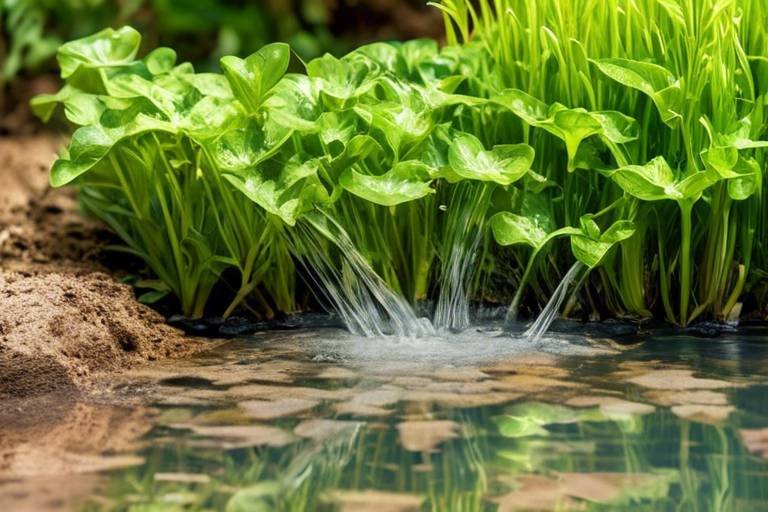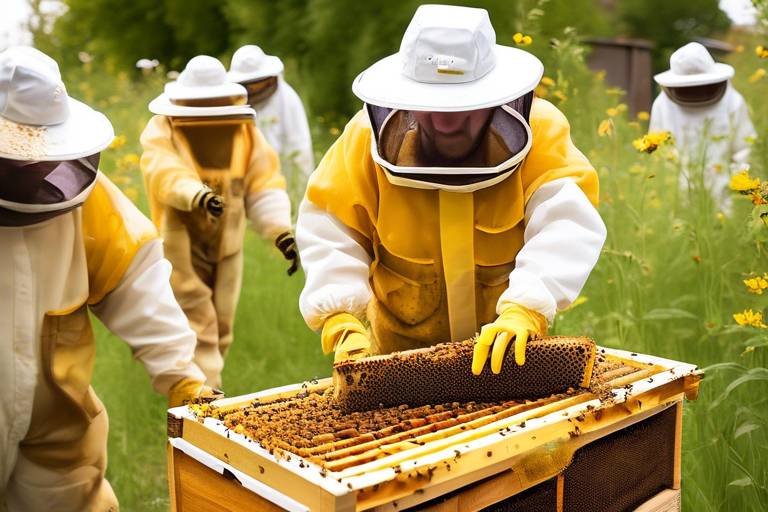How to Create a DIY Zero-Waste Kitchen
Are you ready to revolutionize your kitchen into a sustainable haven of zero waste? Creating a DIY zero-waste kitchen is not only beneficial for the environment but also for your wallet. By incorporating simple projects and eco-friendly practices, you can make a significant impact on reducing waste and living a more sustainable lifestyle.
One of the key elements in achieving a zero-waste kitchen is setting up a composting station. By recycling food scraps and turning them into nutrient-rich soil, you can close the loop on organic waste and contribute to a healthier garden. Imagine the satisfaction of knowing that your kitchen scraps are being transformed into a valuable resource for your plants.
When it comes to reducing waste, opting for reusable alternatives is a game-changer. Say goodbye to single-use items and embrace cloth napkins, beeswax wraps, and glass containers. These simple swaps not only help the environment but also add a touch of elegance to your kitchen. It's a win-win situation for both style and sustainability.
Upcycled decor is another creative way to infuse sustainability into your kitchen. By repurposing old kitchen items into stylish decor pieces, you not only give them a new life but also reduce waste in a unique way. It's like turning trash into treasure, adding a personal and eco-friendly touch to your space.
Meal planning is a powerful tool in the zero-waste kitchen arsenal. By strategizing your meals, you can minimize food waste, save money, and streamline your grocery shopping routine. It's all about being intentional with your ingredients and making the most out of what you have. Plus, who doesn't love the convenience of having meals planned out in advance?
DIY cleaning products are not only cost-effective but also eco-friendly. With natural ingredients like vinegar, baking soda, and essential oils, you can create effective cleaning solutions that are gentle on the environment and your health. Say goodbye to harsh chemicals and hello to a sparkling, toxin-free kitchen.
Water conservation plays a crucial role in a zero-waste kitchen. Simple practices like fixing leaks, using the dishwasher efficiently, and collecting rainwater for plants can make a significant difference in reducing water waste. It's about being mindful of your water usage and finding creative ways to conserve this precious resource.
Optimizing kitchen storage is essential for a clutter-free and eco-friendly space. Decluttering excess items, organizing essentials, and utilizing space-saving solutions can transform your kitchen into a minimalist haven. Imagine a kitchen where everything has its place, making cooking and meal prep a breeze.
Engaging with your local community is a fantastic way to promote sustainability and reduce waste. Whether it's participating in food swaps, sharing excess produce, or joining community composting programs, community sharing fosters a sense of connection and collective responsibility towards the environment. Together, we can make a difference, one kitchen at a time.

Composting Station
Learn how to transform your kitchen into a sustainable, zero-waste space with simple do-it-yourself (DIY) projects and eco-friendly practices.
Setting up a composting station in your kitchen is a fantastic way to recycle food scraps and create nutrient-rich soil for your garden. By separating organic waste from other trash, you can reduce the amount of garbage going to landfills and instead turn it into valuable compost that enriches the soil. A compost bin or container in your kitchen makes it convenient to collect food scraps like fruit and vegetable peels, coffee grounds, and eggshells. These organic materials can then decompose and transform into a natural fertilizer that benefits your plants and reduces your environmental impact.

Reusable Alternatives
When aiming to create a zero-waste kitchen, incorporating is a game-changer. Imagine replacing your disposable items with eco-friendly options that not only reduce waste but also add a touch of style to your kitchen. One fantastic alternative is using cloth napkins instead of paper towels. These reusable napkins not only help in cutting down on paper waste but also bring a sense of elegance to your dining table.
Another excellent choice for sustainable living is beeswax wraps. These wraps made from beeswax-infused fabric are perfect for covering food items and replacing plastic cling wraps. They are washable and reusable, making them a durable and environmentally friendly option for preserving your food.
When it comes to storing leftovers or meal prepping, consider using glass containers instead of disposable plastic ones. Glass containers are not only safer for storing food but also help in reducing single-use plastic waste. Plus, they are easy to clean and maintain, making them a convenient choice for a zero-waste kitchen.

Upcycled Decor
When it comes to creating a sustainable and eco-friendly kitchen, upcycled decor can play a significant role in reducing waste and adding a unique touch to your space. Instead of throwing away old kitchen items, consider repurposing them into stylish decor pieces that not only enhance the aesthetics of your kitchen but also contribute to a more sustainable lifestyle.
One creative idea for upcycled decor is turning old mason jars into charming herb planters. By simply adding some soil and herb seeds to the jars, you can create a functional and visually appealing addition to your kitchen. This not only reduces waste by giving new life to old jars but also provides fresh herbs for cooking, eliminating the need for store-bought alternatives packaged in plastic.
Another innovative upcycling project is transforming wooden crates into rustic shelves. These shelves can be used to display kitchen essentials or decorative items, adding a touch of character to your space. By upcycling wooden crates, you not only prevent them from ending up in a landfill but also create a unique storage solution that reflects your personal style.
Old kitchen utensils can also be repurposed into decorative elements. For example, vintage silverware can be arranged artistically on a wall to create a one-of-a-kind kitchen display. This not only showcases your creativity but also gives a new purpose to items that would have otherwise been discarded.
Upcycled decor allows you to infuse your kitchen with personality and sustainability, turning ordinary items into extraordinary pieces that tell a story. By incorporating upcycled decor into your kitchen design, you not only reduce waste but also inspire others to embrace creativity and resourcefulness in their own homes.

Meal Planning
Learn how to transform your kitchen into a sustainable, zero-waste space with simple do-it-yourself (DIY) projects and eco-friendly practices.
Meal planning is like creating a roadmap for your culinary journey. By taking the time to plan your meals ahead, you not only save time but also reduce food waste significantly. Imagine having a week's worth of meals planned out, knowing exactly what ingredients you need and how to utilize them efficiently. It not only saves you from last-minute grocery runs but also ensures that every item you buy gets used, preventing food spoilage and unnecessary purchases.
One effective way to approach meal planning is by creating a weekly menu. Sit down, brainstorm some meal ideas, check your pantry and fridge for ingredients, and jot down a list of meals for each day. This not only helps you stay organized but also allows you to make the most out of what you have on hand. Additionally, consider batch cooking - preparing larger portions of food and freezing individual servings for later use. This not only saves time on busy days but also reduces the temptation to order takeout, thus cutting down on packaging waste.
Another aspect of meal planning is understanding portion sizes. By cooking just the right amount of food needed, you can avoid leftovers that might go to waste. It's like a puzzle where you fit the pieces perfectly, leaving no room for excess. Moreover, meal planning can also help you budget better, as you shop with a purpose and avoid impulse buys that often lead to unused items being thrown away.
When planning your meals, consider incorporating seasonal and local produce. Not only does this support sustainable farming practices, but it also reduces the carbon footprint of your meals. By aligning your menu with what's in season, you not only enjoy fresher ingredients but also contribute to a more eco-friendly kitchen.
Meal planning is not just about saving time and money; it's a mindful approach to cooking and consuming food. It allows you to appreciate the ingredients you have, get creative with your recipes, and make conscious choices that benefit both your well-being and the environment. So, next time you step into the kitchen, take a moment to plan ahead and savor the satisfaction of a well-thought-out meal.
Stay tuned for some common questions and answers about creating a DIY zero-waste kitchen!

DIY Cleaning Products
Learn how to transform your kitchen into a sustainable, zero-waste space with simple do-it-yourself (DIY) projects and eco-friendly practices.
When it comes to keeping your kitchen clean and eco-friendly, making your own DIY cleaning products can be a game-changer. By using natural ingredients like vinegar, baking soda, and essential oils, you can create effective cleaners that are safe for your family and the environment.
Imagine a world where your kitchen sparkles without harsh chemicals, where the fresh scent of essential oils lingers in the air long after you've cleaned. With just a few simple ingredients, you can whip up your own all-purpose cleaner, disinfectant spray, and even dishwasher detergent.
Not only are DIY cleaning products better for the planet, but they are also gentler on your wallet. Say goodbye to expensive store-bought cleaners filled with unknown chemicals and hello to a greener, more budget-friendly way of cleaning.
By creating your own cleaning products, you have full control over what goes into them, ensuring that your kitchen surfaces are not only clean but also free from harmful toxins. Plus, the satisfaction of making something yourself adds an extra layer of joy to the cleaning process.
So, roll up your sleeves, gather your ingredients, and get ready to revolutionize your cleaning routine with DIY products that are as effective as they are environmentally friendly.
Have more questions about creating a zero-waste kitchen or any of the DIY projects mentioned? Check out the FAQs below:
Q: Are DIY cleaning products as effective as store-bought ones?
A: Yes, DIY cleaning products can be just as effective, if not more so, than store-bought cleaners. Natural ingredients like vinegar and baking soda have powerful cleaning properties that can tackle dirt and grime effectively.
Q: Will DIY cleaning products save me money?
A: Absolutely! Making your own cleaning products is much more cost-effective than buying commercial cleaners. With just a few basic ingredients, you can create a variety of cleaners that will last you a long time.
Q: Are DIY cleaning products safe for pets and children?
A: Yes, DIY cleaning products made with natural ingredients are generally safe for pets and children. However, it's always a good idea to store them out of reach and use them in well-ventilated areas.

Water Conservation
Learn how to transform your kitchen into a sustainable, zero-waste space with simple do-it-yourself (DIY) projects and eco-friendly practices.
Water conservation is a crucial aspect of creating a sustainable kitchen. By implementing water-saving practices, you not only reduce your environmental impact but also save money on utility bills. One effective way to conserve water is by fixing leaks promptly. A dripping faucet may seem insignificant, but over time, it can waste a significant amount of water. Additionally, using a dishwasher efficiently can help save water compared to hand washing. Ensure the dishwasher is fully loaded before running a cycle, and opt for the eco-friendly setting if available. Another innovative way to conserve water is by collecting rainwater for your plants. Installing a rain barrel in your garden allows you to harness nature's gift and reduce the need for tap water, promoting sustainability in your home.

Minimalist Storage
In a world where clutter seems to multiply overnight, embracing minimalist storage solutions can be a game-changer for your kitchen. Picture this: a serene and tidy space where every item has a purpose and a designated spot. By decluttering excess items and organizing essentials efficiently, you not only create a visually appealing kitchen but also contribute to a more sustainable lifestyle.
One effective way to achieve minimalist storage is by utilizing multifunctional furniture pieces. Consider investing in a kitchen island with built-in storage compartments or wall-mounted shelves that serve both decorative and practical purposes. These pieces not only maximize space but also add a touch of elegance to your kitchen.
Another strategy is to adopt a "less is more" approach when it comes to kitchen gadgets and tools. Evaluate your collection and keep only the items you use regularly. By simplifying your kitchen inventory, you not only free up valuable storage space but also make cooking and meal preparation more efficient.
Additionally, implementing space-saving solutions can work wonders in a compact kitchen. Utilize vertical space by installing hooks for hanging pots and pans or mounting shelves to store spices and condiments. Drawer dividers and stackable containers are also great allies in maintaining order and maximizing storage capacity.
Furthermore, creating designated zones for specific categories of items can streamline your storage system. Designate separate areas for pantry staples, cooking utensils, and cleaning supplies to facilitate easy access and prevent clutter from creeping back in.
By embracing minimalist storage practices in your kitchen, you not only create a harmonious and functional space but also contribute to a more sustainable lifestyle by reducing unnecessary consumption and waste. Remember, a clutter-free kitchen is not only visually appealing but also promotes a sense of calm and efficiency in your daily cooking endeavors.

Community Sharing
Community sharing is a wonderful way to connect with your local community and promote sustainability in your kitchen. By engaging in activities such as food swaps, sharing excess produce, or participating in community composting programs, you not only reduce waste but also build relationships with like-minded individuals. Food swaps allow you to exchange homemade goods with others, fostering a sense of community and reducing food waste. Sharing excess produce from your garden or kitchen not only prevents food from going to waste but also encourages a culture of sharing and generosity.
Participating in community composting programs is another impactful way to reduce waste and contribute to a greener environment. By collectively composting organic waste, the community can create nutrient-rich soil for gardens and reduce the amount of waste sent to landfills. This cooperative effort not only benefits the environment but also strengthens the bonds within the community, creating a sense of shared responsibility for sustainability.
Frequently Asked Questions
- 1. How can I start composting in my kitchen?
Begin by designating a compost bin for food scraps, including fruit and vegetable peels, coffee grounds, and eggshells. Layer the organic waste with dry materials like leaves or shredded paper to maintain a proper balance. Turn the compost regularly to aerate it and speed up the decomposition process.
- 2. What are some easy DIY cleaning products I can make for my kitchen?
You can create a simple all-purpose cleaner by mixing equal parts water and vinegar, adding a few drops of essential oils for fragrance. For a scrub, combine baking soda with water to form a paste. To freshen the air, simmer citrus peels and spices on the stove or use a homemade room spray with water and your favorite essential oils.
- 3. How can I reduce water waste in my kitchen?
Fix any leaky faucets or pipes promptly to prevent water wastage. Use a dishwasher only when it's full to maximize water efficiency. Consider installing a low-flow aerator on your kitchen faucet and collect rainwater in a barrel to water your plants, reducing the need for additional water usage.



















